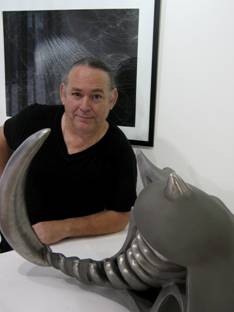|
Henderson feels, “Stone is stored feeling capital; it will be around for thousands of years.” A very Chinese condition. Hiswork suggests however, that our temporary man made plastic gadgets's, are, in some unseen dimensions, ubiquitous and enormously influential. There are social consequences. “The cell phone has become the remote control for our lives – we use it for electronic banking, purchases, mail and many other applications. Thanks to this convenience we do much less face to face, and have much less contact, especially with the common person on the street.”
He reflects on China's challenges through the lens of his own history. Tashi Hashimoto, a Japanese inventor and Henderson's mentor until he died in 1995, was responsible for bringing the answer phone and Caller ID to the world in the late 1950s.“Japan was not really inventive, Henderson notes, but brilliant at realizing other people's ideas. The situation not the same for China; China invented many things a long time ago that we take for granted. As China becomes more dependent on trading relationships it will care more about intellectual property rights. But it started out counterfeiting, copying and importing like Japan; I believe they will become innovators in their own right.” The beauty of this work in stone as versus his work in software, is that it doesn't spawn intellectual property right law suits.
In the meantime he feels what we really to work out now are the ethics, because “once it's out there, we are all affected much the same way by technology. The challenge is great for China as a nation, and this elbows down to us individually when we consider the changes wrought by technology that are completely out of our control.”
The ethics we develop to guide the use of technologies and
how we resolve the problems they create will determine their
ultimate value to civilization.
This is Daniels first trip here but won't be his last. “China has a wonderful rich history of stone work, some of it quite astonishing”: he is referring the Hui'an culture of women stone carvers. “That was a surprise to me – being a man I think of stone carving as a macho thing, a man's art.”
 |
|
Robert Michael Smith of the Digital Stone Project in his Beijing Tomorrow Art Gallery in front of a sculpture realized with computer graphics. |
Robert Michael Smith is Henderson's link to China. Smith was one of four sculptors behind the Digital Stone Project that toured four Chinese cities between the fall of 2008 and the winter of 2009, and spawned a gallery collective in Beijing this year. He arrived in China a month after his friend Bruce Beasley, whose sculpture Gathering of the Moons is permanently installed in Beijing's Olympic Park. They were checking out dozens of large scale stone carving facilities in and near Chongwu just north of Xiamen that might be able to produce his huge outdoor sculptures. The facility they selected would work from the products of a “3D printer” – a machine that looks a little like a prop from a low budget sci-fi movie; it takes the artists computer-generated designs and delivers a small scale model in plastic, meaning that designs can be done anywhere in the world, then rendered in miniature for shipping. Carvers anywhere in the world then take the model, or rapid prototype, and produce in granite the final piece at the scale specified by the artist.
|
